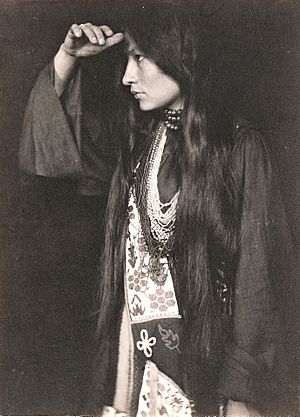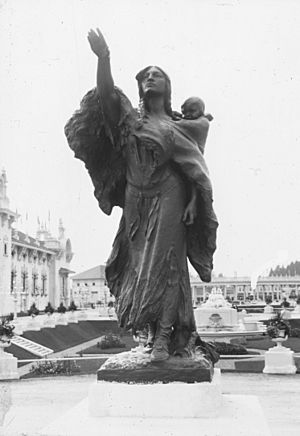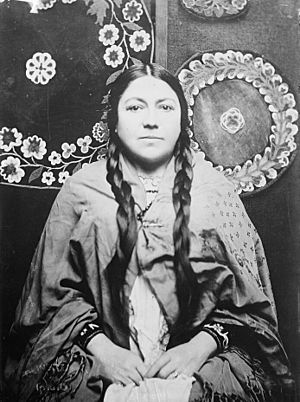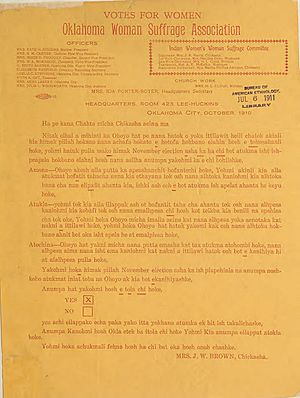Native Americans and women's suffrage in the United States facts for kids
Native American women played an important role in the fight for women's right to vote in the United States. Early women's rights activists, like Elizabeth Cady Stanton and Lucretia Mott, learned from Native American societies, especially the Iroquois nations. These societies often treated women with more equality than was common in white American society at the time. While some suffragists looked up to Native American women, others sadly left them out of the movement. Even after the 19th Amendment gave many women the right to vote in 1920, Native American women still faced challenges. It wasn't until 1924 that many Native Americans gained the right to vote through the Indian Citizenship Act. However, even then, some states created extra rules that made it hard for Native Americans to vote.
Contents
How Native American Women Inspired the Suffrage Movement
Early groups fighting for women's rights in the United States were inspired by Native American women. This was especially true for women from the Iroquois nations. In 1848, Lucretia Mott visited the Seneca people. She saw that women in their society had more equal roles than women in her own culture.
When Mott was planning the Seneca Falls Convention, she shared stories about how the Seneca people treated women equally. She also talked about how Seneca women took part in their tribal government. Iroquois women often led family groups. They also helped choose and watch over the leaders in their communities. Mott saw that women in these groups worked to be more independent.
Matilda Joslyn Gage and Other Influences
Matilda Joslyn Gage was also inspired by the Iroquois way of life. Gage believed that Native societies showed a good way to create lasting peace. She wrote articles praising Native cultures like the Iroquois. She highlighted how women contributed to their society and made important decisions.
Lydia Maria Child also saw Native American social structures as a different way of life. She felt it was an alternative to a society where men held all the power. Elizabeth Cady Stanton even called the Iroquois culture "matriarchal," meaning women held a lot of power.
Louise McDonald Herne, a Bear-clan mother of the Mohawk Nation, said that Native women "showed white women what freedom and liberty really looked like." Alice Cunningham Fletcher shared stories about the equal rights of women in Native American cultures. She spoke at the International Council of Women in 1888. In 1891, Stanton again spoke about the power women had in Iroquois culture.
Sacagawea's Role in Oregon
Eva Marie Dye, who led the Oregon Equal Suffrage Association, worked to make Sacagawea a national hero. Sacagawea was a Lemhi Shoshone woman who helped the Lewis and Clark Expedition. Dye's efforts to create a statue honoring Sacagawea were very important to the suffrage movement in Oregon. The National American Woman Suffrage Association held its national meeting when the statue was revealed in Portland in 1905.
In 1909, suffragist Sophia Loebinger brought three Iroquois people to her speech. She said, "I am reminded that many years ago the Iroquois tribes were ruled by women. They had their council of matrons and that is why their early government was so powerful."
In 1913, it was advertised that "Dawn Mist" and friends would march in the Woman Suffrage Procession. However, Dawn Mist was not a real person. The Great Northern Railway had hired Native American women to act as Dawn Mist. This was a way to get publicity for the railroad company.
Native American Suffragists
In 1866, Cayuga physician Peter Wilson encouraged members of the New-York Historical Society to support women's right to vote.
In Oklahoma, Native Americans and non-Native suffragists started working together in 1904. The Oklahoma Woman Suffrage Association even reached out to Chickasaw people in their own language. They encouraged them to support women's suffrage.
Marie Louise Bottineau Baldwin (Métis from the Turtle Mountain Band of Chippewa Indians) took part in a 1913 suffrage parade in Washington. She chose to march as a "modern woman" instead of using old, untrue images of Native women. Baldwin also marched in the 1913 Woman Suffrage Procession in Washington, D.C.
Native American women also joined suffrage demonstrations at the South Dakota state fair in Huron.
After the 19th Amendment was passed in 1920, Zitkala-Sa (Yankton Sioux) reminded white women that Native American women still could not legally vote. Laura Cornelius Kellogg (Oneida) pointed out that white women had finally gained what Native American women already had in their tribal communities. Zitkala-Sa worked hard to get the United States Congress to allow Native American people to vote in 1924.
Lucy Nicolar Poolaw (Penobscot) and her sister, Florence Shay (Penobscot), fought for the right of Native Americans living on reservations in Maine to vote. In 1955, Poolaw became the first Native American living on a reservation to vote in Maine.
Voting Rights for Native Americans
In 1915, Alaska's government gave Alaska Natives the right to vote. However, they had to give up their tribal customs and traditions to do so.
In 1924, Native Americans were recognized as United States citizens through the Snyder Act. This meant they were supposed to have the right to vote. But many states then started using rules that had been used to stop Black voters from voting. These rules were now used against Native American voters.
Arizona and New Mexico did not allow Native Americans to vote until 1948. Native Americans living on reservations in Maine could not vote until 1954. Utah allowed Indigenous people to vote in 1957. When the Voting Rights Act of 1965 was passed, Native Americans had better access to voting rights. However, they still faced special challenges.
Why Some Native Americans Were Excluded
Many suffrage groups did not try to include Native American women. Some white suffragists, like Carrie Chapman Catt, believed that white women should get the right to vote before Native women. Anna Howard Shaw also thought that Native Americans did not deserve to vote. She spoke out against giving Native people the vote in South Dakota during the 1890s.
Images for kids






